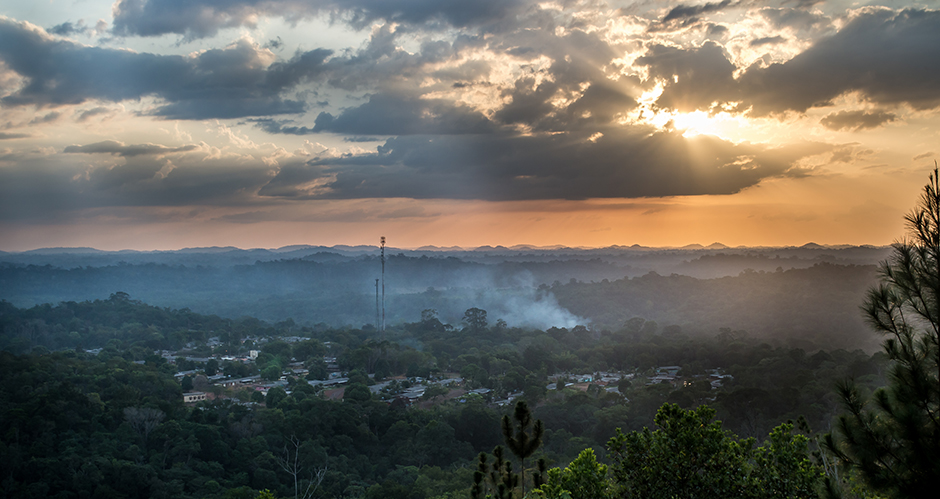Years of research on the Brazilian Amazonia’s rich biodiversity and ecological functions has documented the region’s importance to humanity and the planet. Yet, Brazil’s rainforest is under stress from many of the very initiatives, including agriculture like soybean farms and the expansion of infrastructure, such as roads and dams, thought to be essential for the well-being of its population.
But in a new study, University of Miami Professor José Maria Cardoso da Silva, in the Department of Geography and Regional Studies, found that many of the theories about how societies living in tropical forest regions can improve their living standards, which include deforestation, migration, public investment, and agriculture, do more harm than good because they fail to conserve the region’s natural wealth—the forest.
“Essentially, regions covered by forests, which are so important on a global scale because of climate change, must follow a different developmental pattern because these regions are fundamentally different,” Silva said. “The only way to improve human welfare is by protecting the forest while building up modern and sustainable infrastructure in the region’s cities.”
For his study, Silva and co-author Shivangi Prasad, a UM lecturer, evaluated whether reducing the forest to make way for development, migrating from small cities to larger cities, investing in government pensions, subsidies, and social welfare programs, and increasing agriculture and other jobs, improved human welfare in the Brazilian Amazonia by looking at how the Human Development Index (HDI) of 499 municipalities in the region changed from 2005 to 2012, when the government implemented strategies to control deforestation and promote more sustainable development.
“We used HDI as a proxy for human well-being because it measures the overall income, health, and education of a population and gives a ranking between zero and one, zero being very bad and one very good,” said Silva. “What we found in our study is that increases in urbanization, agriculture, and public investment projects, during a time of reduced deforestation, does not translate into high human development growth, unless they are done correctly and take into account the importance of the forest itself.”
These theories, the study found, all proved unsuccessful due to improper planning and capacity of the local municipal governments in the Brazilian Amazonia to develop and implement sound, long-term sustainable development plans. According to the study, deforestation creates a kind of “boom-and-bust” pattern where there are short-term economic gains but long-term losses; fast urbanization means people move from impoverished rural areas to big cities where resources are also lacking; public investment is mismanaged by the government and limits entrepreneurship; and agriculture is negatively correlated with human development because a lack of clarity about land ownership creates social conflicts with, for example, indigenous people. All of these factors actually reduce HDI growth, the researchers found.
Prasad, Silva’s co-author who lectures in the Department of Geography and Regional Studies, says the research can be applied to other countries where tropical rainforests and people intermingle, such as Indonesia and countries in the Congo Basin—global areas with very large tropical rainforest regions. Prasad said deforestation within the tropical areas of Indonesia is giving way to single-crop farming while countries in the Congo Basin, which have the second largest tropical rainforest in the world and very low HDI, deforestation is happening because of poor governance and, consequently, well-thought, long-term development plans that consider the rights and wishes of the local populations.
“If you look at our research, this is exactly what is happening in the Amazon where deforestation is being replaced by soybeans, while in Indonesia it’s palm oil plantations,” said Prasad. “The problem when growing just one crop is that it reduces biodiversity. Also, the way the land is cleared is also a problem because mass deforestation of large swaths of land are cleared by fire.”
Prasad says she was somewhat surprised by their findings on urbanization. “One would think that urbanization would increase human welfare due to better access to healthcare, education and quality government services in urban areas,” she said. “Yet, in our study, we did not find a positive connection between urbanization and HDI growth, especially in the context of the Amazon, where the population of the urban centers are growing so fast that the region’s cities do not have time to build up the infrastructure and services to accommodate them.”
In conclusion, Silva said, “I am a strong believer that without the outright conservation of the natural ecosystems, no country in the world can be considered as developed if it does not find ways to conciliate economic prosperity with a healthy environment.”
The study entitled, “The impact of deforestation, urbanization, public investments, and agriculture on human welfare in the Brazilian Amazonia,” is published in the journal Land Use Policy.
February 15, 2018

